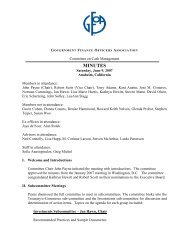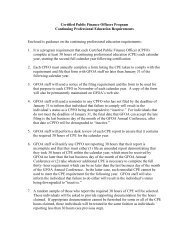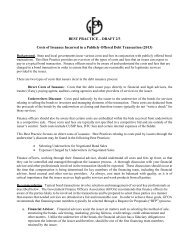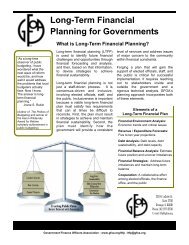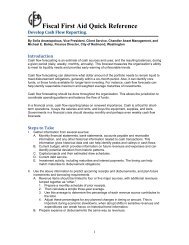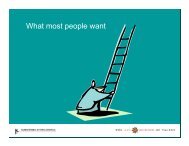C Coaching Your Team To Effective Leadership
C Coaching Your Team To Effective Leadership
C Coaching Your Team To Effective Leadership
You also want an ePaper? Increase the reach of your titles
YUMPU automatically turns print PDFs into web optimized ePapers that Google loves.
MANAGEMENT & CAREERS<br />
<strong>Coaching</strong> <strong>Your</strong> <strong>Team</strong> to <strong>Effective</strong> <strong>Leadership</strong><br />
By Beth Bratkovic<br />
People are perceived as<br />
leaders when their<br />
intentions and actions<br />
are informed by<br />
a desire to enhance<br />
the lives of others<br />
through individual<br />
relationships, business<br />
outcomes, community<br />
change, and so on.<br />
“If your actions inspire others to dream<br />
more, learn more, do more, and<br />
become more,you are a leader.”<br />
— John Quincy Adams<br />
Developing leadership is not an<br />
easy task. And before one can<br />
help others to become leaders,<br />
it is necessary to define the concept —<br />
which is not an easy task,either.It is not<br />
a term one can apply to oneself, but a<br />
concept based on the perception of<br />
others. Managing others does not necessarily<br />
make someone a leader, either.<br />
There are many characteristics that<br />
make people successful individual contributors<br />
and team members, but leadership<br />
requires a larger definition of<br />
oneself and one’s place in an organization.<br />
People are perceived as leaders<br />
when their intentions and actions are<br />
informed by a desire to enhance the<br />
lives of others through individual relationships,<br />
business outcomes, community<br />
change, and so on.<br />
THE KEY CHARACTERISTICS<br />
Courage. Former British Prime<br />
Minister <strong>To</strong>ny Blair famously said, “The<br />
art of leadership is saying no,not yes.It is<br />
very easy to say yes.” <strong>Leadership</strong> shines<br />
during times of adversity because that is<br />
when the courage to take an unpopular<br />
stance is most needed.Being honest and<br />
making tough decisions does not always<br />
make people feel good. <strong>Leadership</strong> is<br />
not for the meek. People often claim<br />
positions of leadership,but then do nothing<br />
when the tough times arrive,abdicating<br />
responsibility, throwing their hands<br />
up and saying there was nothing they<br />
could do.<br />
Discipline. <strong>Leadership</strong> requires discipline<br />
— a consistency in values,actions,<br />
and language. <strong>To</strong> be a leader, one must<br />
practice the behaviors required for<br />
effective leadership. The key word is<br />
“practice.” The average manager receives<br />
five days of training per year, with little<br />
or no follow up to establish the skills<br />
taught in these sessions. 1 There are few,<br />
if any, expectations that managers will<br />
actually apply these skills on the job.<br />
These managers are about as likely to be<br />
leaders as someone who takes a weeklong<br />
guitar class is to be a musician.<br />
Interpersonal Abilities. Leaders use<br />
their interpersonal capabilities to influence<br />
those around them. They do not<br />
force anything, but rather ask the questions<br />
that allow people to think differently<br />
about the topic at hand.<br />
Interpersonal abilities are revealed in<br />
many ways — for instance, effective listening<br />
instills trust; strong written and<br />
oral communication establishes credibility.<br />
Being able to read people and<br />
adjust one’s style based on the body<br />
language of others creates an environment<br />
of candor and openness. All of<br />
these skills allow for solid,ongoing relationships,<br />
which in turn provide partnerships<br />
and the foundation by which<br />
work gets done.<br />
Interpersonal ability is often described<br />
as a soft skill, but soft skills are at<br />
56 Government Finance Review | February 2009
least as essential to personal and organizational<br />
success as technical skills.<br />
Leaders must be capable of influencing<br />
the people who report to them, other<br />
managers, higher-ups, other members of<br />
the community — the list is endless.<br />
Interpersonal savvy also requires selfawareness,<br />
a personal, implicit understanding<br />
of one’s strengths and weaknesses.<br />
Leaders must be willing to see<br />
the things in themselves that need to be<br />
changed, realize how these blind spots<br />
and biases affect their perceptions and<br />
decision making, and then set about<br />
changing them. Self-awareness allows<br />
people to make themselves better.<br />
Making It Happen. Leaders have a<br />
reputation of doing what they say they<br />
will do. This is the evidence, the proof,<br />
and the baseline for trust and credibility.<br />
Someone who does not get the<br />
work done does not have credibility as<br />
a professional.<br />
At the same time,the occasional spot<br />
of incompetence is not necessarily a<br />
bad thing. People need to take risks,<br />
learn new skills, try new things, or start<br />
new jobs.The important thing is to keep<br />
a firm grasp on one’s limitations and<br />
acknowledge them. People who are<br />
expanding their abilities or making<br />
transitions can avoid damaging their<br />
credibility by being careful about making<br />
promises regarding new areas of<br />
expertise.<br />
Humility. Leaders do not harbor a<br />
desire to shine beyond all others. A<br />
leader must be willing to point out the<br />
direction of future success and then get<br />
out of the way so those who have the<br />
skills and abilities can accomplish the<br />
goal. A desire for stardom will only<br />
thwart this essential goal. A big ego is<br />
dangerous in a position of leadership.<br />
Having some fun. Humor, creativity,<br />
and fun are both allowed and encouraged.<br />
While leadership is often serious<br />
business, a leader who has a sense of<br />
humor and fun fosters an environment<br />
of innovation and creativity. Serious<br />
times require serious behavior, but not<br />
all times are serious, and joy should be<br />
as much a part of leadership as focus<br />
and discipline.<br />
ENCOURAGING LEADERSHIP<br />
The best way to encourage leadership<br />
in one’s organization is to model leadership<br />
characteristics. As the old saying<br />
goes, “a leader leads by example,<br />
whether he intends to or not.”If employees<br />
are to learn about leadership, they<br />
need to see the right attributes mirrored<br />
in the behaviors, attitudes, and procedures<br />
of the organization.<br />
Helping others become leaders<br />
requires coaching, and lots of it. Since<br />
leadership behaviors are not tactical<br />
skills, there is no one, obvious way to<br />
proceed. Remember that there are multiple<br />
ways to be an effective leader, and<br />
watch for opportunities to learn from<br />
those you are trying to teach.<br />
Informal <strong>Coaching</strong>. We provide<br />
informal coaching to everyone we<br />
come in contact with,every day.The way<br />
we greet people,engage in dialogue,ask<br />
questions, and listen to answers, all provide<br />
insights and feedback to the people<br />
we interact with. For example, our<br />
biases play out in every conversation,so<br />
we need to be mindful of those preferences<br />
and preconceptions.<br />
One excellent informal coaching<br />
method is to catch people doing something<br />
right, then acknowledge and<br />
encourage the behavior. When an<br />
employee influences others by asking<br />
open-ended questions that further the<br />
discussion, acknowledge a job well<br />
done. When someone appropriately<br />
inserts humor into a meeting, show<br />
approval by laughing along with everyone<br />
else. Small acknowledgements of a<br />
job well done do not go unnoticed, nor<br />
do disapproving looks or lack of eye<br />
contact. <strong>To</strong> ensure that good behaviors<br />
will continue, leaders need to show<br />
employees that they saw the behavior,<br />
liked it, and want to see it again.<br />
Informal coaching takes place many<br />
times every day — during a chat in the<br />
hall, a meeting, a planning session, and<br />
so on. <strong>Coaching</strong> takes place during<br />
every contact with employees.<br />
Therefore,we need to be mindful of our<br />
intent, the messages we send, and the<br />
behaviors we encourage. Even seemingly<br />
subtle actions send a message.For<br />
example, one leader — who had a reputation<br />
for being an outstanding leader<br />
and mentor — sat in the center of the<br />
first row to show support for those who<br />
had worked hard to make presentations<br />
at a large department meeting.This was<br />
a thoughtful behavior, and the intent<br />
was spot on. But when this person was<br />
not sitting in the front row during one of<br />
the presentations,everyone got the message<br />
that this presentation was not<br />
important. The leader was actually sitting<br />
at back of the room, paying close<br />
attention,but few people noticed.Those<br />
who are in leadership roles are<br />
watched closely at all times.<br />
Formal <strong>Coaching</strong>. The best way to<br />
help employees develop their leadership<br />
skills is to combine informal and<br />
formal coaching. One formal coaching<br />
technique is to create an assessment of<br />
the characteristics defining effective<br />
leadership for employees to complete,<br />
incorporating their thoughts and feed-<br />
February 2009 | Government Finance Review 57
ack. Employees complete the assessment<br />
and identify ways in which they<br />
demonstrate each of the behaviors and<br />
behaviors they wish to improve, along<br />
with opportunities for doing so.<br />
Another successful technique is to<br />
encourage employees to ask for feedback<br />
about the specific leadership<br />
behaviors they want to work on. The<br />
more specific the questions, the easier<br />
it is to give better feedback. For example,<br />
if an employee asks, “How am I<br />
doing at being courageous?”the answer<br />
might be “fine.”A better question would<br />
be:“At our 1:00 meeting, I was focusing<br />
on providing a different perspective<br />
than my peers. Did you see evidence of<br />
that? What were the examples that you<br />
saw? What could I have done better?”<br />
These questions allow for more specific<br />
feedback and also help coaches pay<br />
attention to the desired behaviors.<br />
The rule of thumb is that it takes 30<br />
days in a row, with no interruptions, to<br />
start a new habit or lose a bad one.<br />
<strong>Coaching</strong> team members to a new<br />
behavior or out of a bad one requires<br />
tenacity on both sides. Be ready for<br />
moments of frustration, and be prepared<br />
to support team members when<br />
they experience the same. But as<br />
employees’ leadership capabilities<br />
begin to grow, celebrate them and<br />
enhance them. Provide opportunities<br />
for employees to use these new skills. It<br />
is well deserved and will continue to<br />
reinforce their success.<br />
CONCLUSIONS<br />
Helping others develop their leadership<br />
potential is a challenging but worthy<br />
endeavor.The basic steps are:<br />
■ Demonstrate leadership. Strive to be<br />
a role model every day, all the time.<br />
■ Define leadership characteristics.<br />
Have examples and stories of what<br />
leaders look like in action.<br />
■ Coach employees and provide feedback<br />
over and over and over again.<br />
■ Celebrate successes.<br />
■ Enjoy the challenge.<br />
Finally, enjoy yourself. You are doing<br />
something right for the individual, the<br />
team,the company,and the community.❙<br />
Note<br />
1.Les Worrall and Cary Cooper,“Management<br />
skills development: a perspective on current<br />
issues and setting the future agenda,”<br />
<strong>Leadership</strong> & Organization Development<br />
Journal 22, 2001.<br />
BETH BRATKOVIC is the vice president of<br />
talent development for General Growth<br />
Properties. She has nearly 20 years of<br />
organization development experience spanning<br />
multiple industries.<br />
Established Reputation.<br />
New Name.<br />
Revenue Generation<br />
■ Utility Rate Studies<br />
■ User Fee (Cost of Service) Studies<br />
■ Cost Allocation Plans<br />
■ Development (Impact) Fee Studies<br />
■ Special District Formation and<br />
Administration<br />
Strategic Financial Planning<br />
■ Fiscal Impact Analysis<br />
■ Facility Financing Plans<br />
■ Annexation and Incorporation<br />
Studies<br />
Compliance Services<br />
■ Arbitrage Rebate<br />
■ Escrow Monitoring<br />
■ Escrow Verification<br />
■ Continuing Disclosure<br />
Management Consulting<br />
■ Organizational Assessments and<br />
Studies<br />
■ Staffing and Outsourcing for New<br />
and Existing Cities<br />
■ Management Training and<br />
Development<br />
■ Administrative Investigations<br />
■ Background Investigations<br />
MuniFinancial has become Willdan Financial Services<br />
and is ready to fulfill your financial and economic consulting needs.<br />
California: Temecula, Lancaster, Oakland, Sacramento; Arizona: Phoenix; Florida: Orlando; Tennessee: Memphis<br />
800.755.6864 | www.willdan.com<br />
58 Government Finance Review | February 2009






